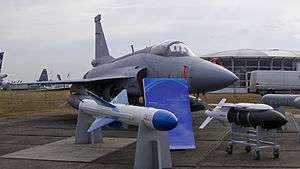YJ-83
| YJ-83 | |
|---|---|
| Type | Anti-ship cruise missile |
| Place of origin | People's Republic of China |
| Service history | |
| In service | 1998 |
| Used by | People's Republic of China |
| Production history | |
| Manufacturer | China Aerospace Science and Industry Corporation |
| Specifications | |
| Warhead | 190 kg. high-explosive fragmentation |
|
| |
Operational range |
180 km(YJ-83) 200 km (YJ-83K) 120 km (C-802) 190 km (C-802A) |
| Speed | Mach 0.9 |
Guidance system | Inertial/active terminal guidance |
Launch platform | Surface |
The YJ-83 (Chinese: 鹰击-83; pinyin: yingji-83; literally: "eagle strike 83") is a Chinese subsonic anti-ship cruise missile. It is manufactured by the China Aerospace Science and Industry Corporation Third Academy.[1]
Description
The YJ-83 uses microprocessors and a strapdown inertial reference unit (IRU); these are more compact than the equivalent electronics used in the YJ-8 and the export C-802, allowing the YJ-83 to have a 180 km. range at Mach 0.9. The missile is powered by the Chinese CTJ-2 turbojet, and carries 190 kg. high-explosive fragmentation warhead. Terminal guidance is by an active radar.[1] The YJ-83K, the air-launched variant, has a range of 200 km.[2] This data may be for an improved YJ-83A; the original YJ-83 may have shorter range, at 120 km and 130 km for the surface- and air-launched versions respectively.[1]
The YJ-83KH has an electro-optical seeker, and may receive course corrections by remote link.[3]
The YJ-83 entered service with the People's Liberation Army Navy in 1998-1999[1] and has equipped a large number of its surface warships.[4] The YJ-83K equips the Xian JH-7 and H-6G.[2]
C-802

The C-802 is the export version of the YJ-83;[4] It is powered by the French TRI 60-2 turbojet[1] and has a range of 65 nautical miles (120 km).[4]
The C-802A and C-802AK are the export surface- and air-launched variants.[1] The C-802A has a range of 100 nautical miles (190 km).[4]
Confusion between the YJ-82, C-802, and "C-803"
The US military considers the C-802 and C-802A as parts of the YJ-83 family.[4]
The C-802 precedes the closely related YJ-83; strictly speaking, only the C-802A is the export development of the YJ-83.[5] The C-802 is sometimes and erroneously considered the export version of the YJ-82; the two are separate developments.[6]
A prospective "C-803" was erroneously promulgated as the export version of the YJ-83 by enthusiasts in the late-1990s.[5] As yet, no such missile exists.
Operators
- Algerian National Navy, C-802[7]
- Myanmar Navy, C-802[9]
- Yemeni Navy, C-802[10]
References
- 1 2 3 4 5 6 Gromley et al.: page 101
- 1 2 3 United States Office of the Secretary of Defense (8 May 2015). Annual Report To Congress: Military and Security Developments Involving the People’s Republic of China 2015 (PDF) (Report). p. 46. Retrieved 24 January 2015.
- ↑ Gromley et al.: page 102
- 1 2 3 4 5 United States Office of Naval Intelligence: page 16
- 1 2 Carlson, Christopher P. (8 February 2013). "China's Eagle Strike-Eight Anti-Ship Cruise Missiles, Part 3". DefenseMediaNetwork. Retrieved 21 April 2016.
- ↑ Carlson, Christopher P. (6 February 2013). "China's Eagle Strike-Eight Anti-Ship Cruise Missiles, Part 2". DefenseMediaNetwork. Retrieved 21 April 2016.
- ↑ Rahmat, Ridzwan (16 March 2016). "Algeria commissions second Chinese-built C28A corvette". IHS Jane's 360. Retrieved 20 April 2016.
- ↑ United States Office of Naval Intelligence: page 17
- ↑ Mazumdar, Mrityunjoy (29 December 2015). "Myanmar commissions second frigate with reduced RCS, hospital ship". IHS Jane's 360. Retrieved 20 April 2016.
- ↑ Binnie, Jeremy (29 October 2015). "Yemeni rebels claim third anti-ship missile attack". IHS Jane's 360. Retrieved 20 April 2016.
- Bibliography
- Gormley, Dennis M.; Erickson, Andrew S.; Yuan, Jingdong (30 September 2014). "A Potent Vector: Assessing Chinese Cruise Missile Developments". Joint Forces Quarterly. National Defense University (75). Retrieved 8 May 2015.
- United States Navy Office of Naval Intelligence (2015). The PLA Navy: New Capabilities and Missions for the 21st Century (PDF) (Report). Retrieved 9 May 2015.